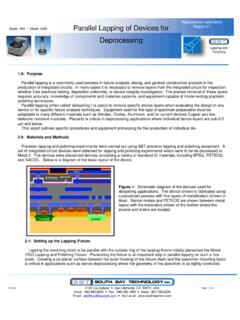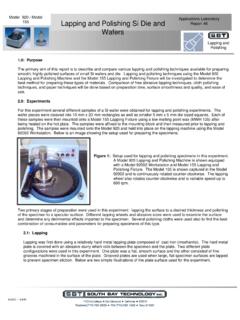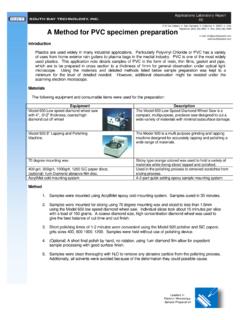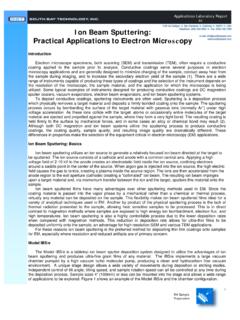Transcription of Maintaining Plate Flatness Prior to Lapping and …
1 1 Lapping and Polishing Purpose Lapping and polishing processes are typically performed on a hard, metal Plate used in conjunction with abrasive suspensions such as diamond , silicon carbide (SiC), aluminum oxide (Al2O3), or boron carbide (B4C). The metal Lapping Plate selected depends upon the desired material removal rate, the surface finish desired, the hardness of the workpiece being lapped, and the Flatness requirement. During the Lapping process material is removed from both the workpiece and the Lapping Plate , which eventually can lead to a Lapping Plate that is out of Flatness . A quick and simple method to measure Plate Flatness can be a useful technique in both monitoring and Maintaining the Flatness of a given Lapping Plate . Using a simple Plate Flatness gauge (PFG) to measure and help maintain Plate Flatness is outlined in this report. Methods used for Plate Flatness are also given for reference.
2 Lapping Plate Characteristics The cast iron Lapping Plate (Model LP 920M) is manufactured to specific tolerances Prior to use. Understanding this tolerance limit will help to demonstrate the effects that Lapping have on the overall Flatness and Plate life during processing. The Lapping plates are generally manufactured with the following Plate specifications: a. Plate Flatness : +/- ( m) b. Plate Parallelism: +/- ( m) Using these values as a guideline for measuring the Flatness of the plates and to determine if they are within specifications helped during this test. Plate Conditioning Plate conditioning is a process by which the Lapping Plate surface is machined to maintain the Flatness of the Lapping Plate and to pre-condition the Lapping Plate surface with the abrasive being used for the Lapping process. Plate conditioning is important for Lapping applications where Flatness and parallelism of the specimen is critical.
3 Specimen quality is a direct result of Plate condition, and therefore proper maintenance of the Lapping Plate is crucial in preparing high quality specimens. Conditioning of the Lapping Plate is affected by three primary parameters: a) position of the conditioning ring, b) weight of the conditioning ring, and c) abrasive size used for Lapping . In this experiment the position of the conditioning ring was studied for effective Plate conditioning. The exact position of the conditioning ring during Plate conditioning will be discussed in a later section. Understanding the mechanisms of Plate conditioning will help in determining a process for effective Lapping and polishing techniques. Cast Fe Conditioning Ring Weight: 1000 grams Inner Diameter: Outer Diameter: Abrasive Size: 35 m SiC (~ 320 grit) Table 1: Conditioning ring parameters used in this experiment Applications Laboratory Report 74 Maintaining Plate Flatness Prior to Lapping and Polishing 2 Lapping and Polishing Procedure The Lapping Plate was measured along six different points using the Flatness Gauge.
4 The gauge was first zeroed on a granite-leveling block to find the zero position and to use that as a reference from which to measure the Plate . Plate measurements were taken and plotted on a graph, using six measurement locations. Measurements were done after each conditioning step to illustrate the change in Plate shape. An illustration of the measurement technique is given below. Figure 1: Illustration of the technique used for measuring the Plate Flatness using the Plate Flatness Gauge. At left is a side view of the process, showing the six measurement locations used to determine the Flatness of the Plate . At right is a top down view of the same process, showing the positioning of the Plate Flatness Gauge in relation to the Lapping Plate surface. The digital micrometer attached to the Plate Flatness Gauge is adjustable, allowing positioning of the micrometer along any point of the Lapping Plate .
5 Conditioning of the Lapping Plate surface is affected by the position of the conditioning ring on the Lapping Plate surface. Generally there are about four different positions that are used for Plate conditioning and are shown schematically below. Figure 2: Schematic illustration of the conditioning ring positions during Plate conditioning. Lapping Plate Flatness Gauge 123456 Measurement locations Lapping Plate Flatness gauge CONDITIONING RING LOCATION ACONDITIONING RING LOCATION BCONDITIONING RING LOCATION CCONDITIONING RING LOCATION D 3 Lapping and Polishing Results A used cast iron Lapping Plate was initially measured using the methods described above. The Plate was subsequently conditioned until the Plate shape resulted in a relatively flat Lapping Plate within the specified tolerances of the manufacturing process. The progression of Plate conditioning is given in the following graphs. Figure 3: Plate Flatness following conditioning for 5 minutes.
6 Conditioning ring was held in position 2 during the Plate conditioning process. Figure 4: Plate Flatness following conditioning for a total time of 20 minutes. The conditioning ring was held in position 1 during this process. Plate Flatness Measured with Flatness Gauge: Pre and Post Conditioning5 minute conditioning, RUN 1-6-4-20246123 456 Measurement LocationHeight ( m)PRE TOLERANCE Plate Flatness Measured with Flatness Gauge: Pre and Post Conditioning15 minute conditioning, RUN 2-6-4-20246123456 Measurement LocationHeight ( m)PRE TOLERANCE 4 Lapping and Polishing Figure 5: Plate Flatness following conditioning for a total time of 20 minutes. The conditioning ring was held in position 3 during this process. Figure 6: Plate Flatness following conditioning for a total time of 45 minutes. The conditioning ring was initially held in position 4 and then moved to position 1 for final conditioning.
7 The Plate Flatness has been brought back into specification without much problem. Plate Flatness Measured with Flatness Gauge: Pre and Post Conditioning10 minute conditioning, RUN 3-10-8-6-4-20246810123456 Measurement LocationHeight ( m)PRE TOLERANCE Plate Flatness Measured with Flatness Gauge: Pre and Post Conditioning25 minute conditioning, RUN 5-8-6-4-202468123456 Measurement LocationHeight ( m)PRE TOLERANCE 5 Lapping and Polishing Conclusion Using a Plate Flatness Gauge to monitor the Flatness of a given Lapping Plate has proved to be very useful in keeping a Plate within a specific tolerance level during Lapping . The gauge is simple and easy to use, providing an effective method for Maintaining Lapping plates and to determine possible errors in the thickness and control of precision Lapping applications. With this simple technique it is easy to determine the shape of the Lapping Plate and the subsequent conditioning parameters required to make the Lapping Plate flat.
8












